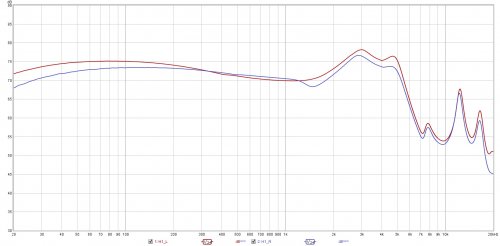INTRODUCTION/DISCLAIMER:

The TRN H1 is an in-ear monitor with a single 6mm graphene-diaphragm dynamic driver that retails between $7-12 at the time of this review. I purchased the H1 from the Nicehck Audio Store on AliExpress for $1 with the expectation of a fair and objective review.
SOURCES
I have used the TRN H1 with the following sources:
Hidizs AP60II > TRN H1
Windows 10 PC > JDS Labs The Element > TRN H1
Windows 10 PC > Hidizs AP60II > TRN H1
Pixel 3 > Fiio BTR1K > TRN H1
Pixel 3 > Apple USB-C to 3.5mm dongle > TRN H1
I have tested these headphones with local FLAC, Spotify Premium, and Youtube Music.
PACKAGING AND ACCESSORIES

The TRN H1 comes in a small square white box. The box has the TRN logo on the front and gives the manufacturer’s contact information on the back. Inside the box are the IEMs, 3 sets of oblong silicone eartips (S, M, L), a user manual, a QC pass chit, and a warranty card. The H1 does not come with a carry bag or case.
BUILD QUALITY / DESIGN

The TRN H1 has a saucer-shaped two-tone black housing with very short nozzles. The inner section is glossy black plastic, and the outer section is matte black metal. There is no branding on the IEM housings, but “L” and “R” are inlaid above the cable entry points. Each earpiece has a rectangular vent on the curved outer lip of the inner housing face and a smaller two circular vent closer to the nozzle. I did not experience any driver flex while using the H1s. The nozzle has a lip for securing eartips.
The H1 has a fixed 4-core braided cable with a straight 3.5mm jack. The TRN logo is printed on the jack housing. The cable does not have pre-formed ear-guides or memory wire. There is no chin-adjustment choker, but the outer housing faces are magnetized so that the IEMs can be secured to each other. The cable is not particularly tangle-prone.
COMFORT / FIT / ISOLATION

The TRN H1 is intended to be worn cable-down only. Comfort is great but isolation is below average. The H1 takes proprietary oblong silicone eartips but can accommodate soft and flexible third-party eartips that can conform to the nozzle shape. I had to use the largest included ear tips to get a good seal.
SOUND
The TRN H1 has a conventional V-shaped tuning.
Sub-bass extension is very good. Kick drum hits have a visceral impact. Mid-bass is moderately elevated without overwhelming the sub-bass but does bleed heavily into the lower mids. There is slightly more slam than rumble. Bass attack and decay are slightly faster than the average dynamic driver. Bass texture is very dynamic.
The lower mids are recessed and perhaps overly warm because of the mid-bass bleed. Male vocals, especially harsh heavy metal vocals, are buried under electric guitars in the elevated upper midrange. The upper midrange is detailed without going overboard with presence. There is a hint of sibilance on female vocals.
Treble is splashy, slightly harsh, especially in the lower treble, and a tad grainy. Treble is lacking in both air and sparkle. Resolution is unremarkable.
Imaging is spot-on. Instrument separation is exceptional for a sub-$10 IEM. Soundstage is larger than average for the price point and compares well with more expensive IEMs.
MEASUREMENTS

My measurements were conducted with a Dayton iMM-6 microphone using a vinyl tubing coupler and a calibrated USB sound interface at a resonance point between 7.5 and 8k. The measurements are presented with 1/24th smoothing and without compensation. Measurements above 10k are not reliable.
AMPLIFICATION REQUIREMENTS AND SOURCE PAIRING
With a sensitivity of 98dB and an impedance of 32ohms, the H1 needs a moderately powerful source to be driven to adequate volumes. The H1 does not hiss.
COMPARISONS
 TRN H1 [$9] vs EZAudio D4 (modded) [$11]
TRN H1 [$9] vs EZAudio D4 (modded) [$11]
Note: The EZAudio D4 has a neutral-bright sound signature out of the box, but I have modded my pair using micropore tape over the bass vents to have more bass than the stock configuration.
The EZAudio D4 has slightly more prominent sub-bass and a slightly larger mid-bass hump. The H1 has more textured bass. The D4’s bass is better articulated and does not bleed into the lower midrange. Even though the D4’s lower midrange is slightly more recessed, it is clearer because the mid-bass hump eases off earlier. The D4 has a more slightly more aggressive upper midrange, with more detail but more sibilance as well. The D4 has more elevated and energetic treble. The D4 is airier and has more realistic transients. The H1’s has slightly better instrument separation and a larger soundstage. Imaging is even between the two. The sensitivity of the two earphones is very similar. Neither benefit from dedicated amplification beyond delivering adequate volume. The H1 is more comfortable and sits more securely. The D4 comes with a soft zippered case.
CLOSING WORDS

The TRN H1 is a respectable entry in the sub-$10 space, with authoritative and textured bass, good build quality, great instrument separation, and an expansive soundstage. They would make excellent sleeping IEMs thanks to the low profile housings.
 Ω
Ω Ω
Ω







